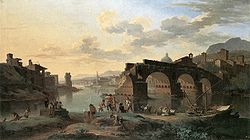
Jacob de Heusch
Encyclopedia

Netherlands
The Netherlands is a constituent country of the Kingdom of the Netherlands, located mainly in North-West Europe and with several islands in the Caribbean. Mainland Netherlands borders the North Sea to the north and west, Belgium to the south, and Germany to the east, and shares maritime borders...
painter. He was Willem de Heusch
Willem de Heusch
Willem de Heusch was a Dutch landscape painter.De Heusch was born and died in Utrecht. Nothing certain is recorded of him except that he presided over the gild of Utrecht, whilst Cornelis Poelenburg, Jan Both and Jan Weenix formed the council of that body, in 1649...
's nephew, signing like his uncle, substituting an initial J for the initial G (of Guglielmo).
De Heusch was born in Utrecht
Utrecht (city)
Utrecht city and municipality is the capital and most populous city of the Dutch province of Utrecht. It is located in the eastern corner of the Randstad conurbation, and is the fourth largest city of the Netherlands with a population of 312,634 on 1 Jan 2011.Utrecht's ancient city centre features...
. He learnt drawing from his uncle, and travelled to Rome
Rome
Rome is the capital of Italy and the country's largest and most populated city and comune, with over 2.7 million residents in . The city is located in the central-western portion of the Italian Peninsula, on the Tiber River within the Lazio region of Italy.Rome's history spans two and a half...
in 1675, where he acquired friends and patrons for whom he executed pictures after his return. According to Houbraken, he became a member of the Bentvueghels
Bentvueghels
The Bentvueghels were a society of mostly Dutch and Flemish artists active in Rome from about 1620 to 1720. They are also known as the Schildersbent .-Activities:...
and made trips to Venice and other cities with friends, painting in the manner of Salvator Rosa
Salvator Rosa
Salvator Rosa was an Italian Baroque painter, poet and printmaker, active in Naples, Rome and Florence. As a painter, he is best known as an "unorthodox and extravagant" and a "perpetual rebel" proto-Romantic.-Early life:...
. After several years in Italy he returned to Utrecht, where he lived with his brother, a postmaster. He continued painting, but was not highly productive, and most of his work was sent to Italy. He enjoyed making pleasure trips, and in 1698 he travelled to Berlin with his Bentvueghel friend Johan Teyler
Johan Teyler
Johannes or Johan Teyler , was a Dutch Golden Age painter, engraver, mathematics teacher, and inventor of the color print.-Biography:...
, and it was on his final pleasure trip to Amsterdam to visit other Bent friends Albert van Spiers and Jan van der Keere, that he vomited blood and died presumably of injuries he had suffered a bit earlier in a fall from a carriage.
According to the RKD his Bent nickname was 'Afdruk' or 'Copia', and he was registered in Rome in 1686, 1691 and 1692.
Like his relative, Jacob was an "Arcadian" and an imitator of Jan Both. He chiefly painted Italian harbour views. His pictures are now scarce. Two of his canvases, the "Ponte Rotto" at Rome, in the Brunswick Gallery, and a lake harbour with shipping in the Lichtenstein collection at Vienna
Vienna
Vienna is the capital and largest city of the Republic of Austria and one of the nine states of Austria. Vienna is Austria's primary city, with a population of about 1.723 million , and is by far the largest city in Austria, as well as its cultural, economic, and political centre...
, are dated 1696.
A harbour with a tower and distant mountains, in the Belvedere at Vienna, was executed in 1699. Other examples may be found in English private galleries, in the Hermitage
Hermitage Museum
The State Hermitage is a museum of art and culture in Saint Petersburg, Russia. One of the largest and oldest museums of the world, it was founded in 1764 by Catherine the Great and has been opened to the public since 1852. Its collections, of which only a small part is on permanent display,...
of St Petersburg and the museums of Rouen
Rouen
Rouen , in northern France on the River Seine, is the capital of the Haute-Normandie region and the historic capital city of Normandy. Once one of the largest and most prosperous cities of medieval Europe , it was the seat of the Exchequer of Normandy in the Middle Ages...
and Montpellier
Montpellier
-Neighbourhoods:Since 2001, Montpellier has been divided into seven official neighbourhoods, themselves divided into sub-neighbourhoods. Each of them possesses a neighbourhood council....
.

